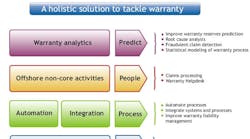Warranty Management: Your Strategic Advantage
"More for less" is the mantra for today. Employers want more out of their employees; OEMs want more out of their suppliers and, of course, customers want more for the money they pay. Contracts are being renegotiated, bigger discounts are being demanded and better service is expected by customers. This also means that customers are frugal and buying cycles are growing longer which in turn makes customer acquisition a daunting task. Therefore, it is of prime importance to improve the quality of engagement with your existing customers.
Also, the slowdown presents an opportunity to reexamine, and realign your organization for the next phase. Thus, it is also imperative for your organization to streamline your operations, improve your bottom line and preserve cash.
Warranty presents the opportunity to do all of the above.
The Evolution of Warranty
Warranty was introduced as a tool to attract customers. Companies wanted to show their customers that they were willing to guarantee their products. They reaped the benefits of this assurance as customers became more than willing to align with companies offering warranties on their products. Soon, the market caught on and everyone was providing warranty on their products for various lengths of time.
Companies soon realized that managing warranty was a task in and of itself. They had to grapple with reverse logistics, claims management, charge back mechanisms. Before they knew, the service became a monster they could not handle.
Warranty management today, however, presents an opportunity to increase your strategic advantage. It can improve customer confidence and through better management, can help reduce operational costs. It also provides the opportunity to generate revenue through up-sell and cross-sell of warranty policies and products.
Warranty Costs
Warranty costs have been rising for some time. Warranty claims paid by U.S. transportation manufacturers have risen by more than 20% in the last five years, according to WarrantyWeek. So why are warranty costs so high? We can categorize warranty costs by three major cost heads:
- process costs
- people costs
- product costs
The high cost of running the warranty process stems largely from the fact that the warranty process is often carried out in an ad-hoc and inefficient manner and usually managed manually. This leads to a lack of visibility in the process and creates greater room for error. Research suggests that warranty costs could be reduced by 55% through warranty lifecycle and product development process improvements.
Warranty administration is a huge cost driver for the warranty department with labor costs contributing the largest component. The cost of setting up a claims processing center and maintaining the work force requires significant resources, especially when run from high cost locations.
Improving the quality of products is one of the key concerns of enterprises today. Furthermore, electronic content in the automobile and industrial equipment sectors is increasing and as a result, the issues and challenges with the products are becoming more and more complex.
The Need for a Holistic Approach
Traditional approaches to tackle warranty management have been narrow and one dimensional leading to short term fixes rather than long term solutions. They have often been implemented without examining its effects on other aspects related to warranty like brand, customer perception and long term value erosion.
The right approach to address warranty is comprehensive and driven by a strategic intent. The approach should also be self-funding which looks for quick wins initially, so as to fund the rest of the project. The solution should also aim to be flexible -- able to accommodate future changes as required, customized to your needs and tailored to deliver maximum ROI
The need for a holistic approach is that, apart from the people, process and product costs, there are several inter-dependencies among the three which if ignored, could lead to an exponential increase in costs.
Organizations need to consider a holistic approach to warranty similar to the figure below. A streamlined warranty process will not only reduce your costs but also allows you to predict your warranty costs and as a result, help manage your warranty reserves. The holistic solution can minimize your warranty costs by up to 60%, as well as improve your top line through up-selling and cross-selling opportunities.The economic slowdown presents an opportunity to reassess and reevaluate, providing an excellent time to connect with your customers and prepare for the next stage of growth. Warranty is a tool by which you can do just that. But to fix warranty's issues you need to take the right approach -- a holistic one that considers issues of process, people and product all together.
Aditya Baliga is Manager-Warranty Management Practice KPIT Cummins which is a global IT consulting and product engineering partner. www.kpitcummins.com
Interested in information related to this topic? Subscribe to our Information Technology eNewsletter.



